Sensor Sweep: Jagged Alliance 2, Baldur’s Gate, Michael Moorcock, Endless Quest
Monday , 18, December 2023 Sensor Sweep Leave a commentEdgar Rice Burroughs (ERB Zine): Edgar Rice Burroughs admired fellow- author Jack London enormously. Following the amazing success of his own early writings, ERB’s ambition was to become a rancher-writer, modeling his life on the one that Jack London had pursued and then abruptly lost due to his sudden death in 1916. In fact, Burroughs and his family were wintering in California when they learned of London’s death. The two authors had never met or corresponded but Ed was deeply moved by London’s passing.
author Jack London enormously. Following the amazing success of his own early writings, ERB’s ambition was to become a rancher-writer, modeling his life on the one that Jack London had pursued and then abruptly lost due to his sudden death in 1916. In fact, Burroughs and his family were wintering in California when they learned of London’s death. The two authors had never met or corresponded but Ed was deeply moved by London’s passing.
 Fantasy (Goodman Games): On the 18th of December, we celebrate the birthday of Michael Moorcock—a big writer with big ideas (regardless of what he thought a handful of decades ago). It’s difficult to rank Moorcock’s diverse achievements in terms of importance or influence. He’s impacted gaming through his Elric stories, he’s been a prolific writer of the Eternal Champion and Multiverse themes, he’s been an influential editor that helped change (dare I say, “improve”) the face of Science Fiction, he’s written comics, and he’s written lyrics for and performed with major rock bands!
Fantasy (Goodman Games): On the 18th of December, we celebrate the birthday of Michael Moorcock—a big writer with big ideas (regardless of what he thought a handful of decades ago). It’s difficult to rank Moorcock’s diverse achievements in terms of importance or influence. He’s impacted gaming through his Elric stories, he’s been a prolific writer of the Eternal Champion and Multiverse themes, he’s been an influential editor that helped change (dare I say, “improve”) the face of Science Fiction, he’s written comics, and he’s written lyrics for and performed with major rock bands!
Robert E. Howard (Sprague de Camp Fan): Robert E. Howard wrote stories of fighting men. His knowledge of weapons came from careful study for the most part. This was needed for the type of fiction he created. He also had practical experience with swords, knives, and guns. Let’s forgo guns for this article and talk about his collection of swords and knives.
of fighting men. His knowledge of weapons came from careful study for the most part. This was needed for the type of fiction he created. He also had practical experience with swords, knives, and guns. Let’s forgo guns for this article and talk about his collection of swords and knives.
Writers (Silver Key): David Drake has passed away. I’m no Drake scholar and unqualified to evaluate his life and career or the majority of his creative output, including the popular Hammer’s Slammers. I’ll leave all that up to someone else. That aside I greatly enjoyed his sword-and-sorcery work wherever I encountered it. I’ve praised his short story “The Barrow Troll” on several occasions and link to the article I wrote for Tales from the Magician’s Skull
Books (Black Gate): The history of Fantasmagoriana is rather complicated.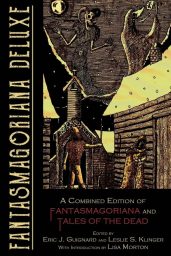 Originally the book was published in German as a ghost story collection, then translated into French in 1812. The first English translation under the title Tales of the Dead by Sarah Elizabeth Utterson appeared in 1813, but Utterson omitted three stories and added one written by herself, “The Storm,” which frankly is an unremarkable, weak imitation of some of the original tales included in the anthology.
Originally the book was published in German as a ghost story collection, then translated into French in 1812. The first English translation under the title Tales of the Dead by Sarah Elizabeth Utterson appeared in 1813, but Utterson omitted three stories and added one written by herself, “The Storm,” which frankly is an unremarkable, weak imitation of some of the original tales included in the anthology.
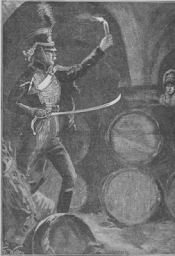 Fiction (Comics Radio): Between 1894 and 1903, Arthur Conan Doyle wrote 17 short stories about a Napoleanic soldier with a tendency to brag about his accomplishments. The stories have an older Gerard, long after Waterloo, describing his adventures as a young officer and mentioning multiple times per story how he always conducted himself with courage and cunning. He’s a great storyteller, though, so the tales he tells are enthralling.
Fiction (Comics Radio): Between 1894 and 1903, Arthur Conan Doyle wrote 17 short stories about a Napoleanic soldier with a tendency to brag about his accomplishments. The stories have an older Gerard, long after Waterloo, describing his adventures as a young officer and mentioning multiple times per story how he always conducted himself with courage and cunning. He’s a great storyteller, though, so the tales he tells are enthralling.
James Bond (The Book Bond): Mark Edlitz, author of the superb The Lost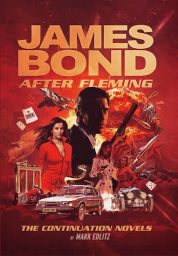 Adventures of James Bond, is back with a new book, James Bond After Fleming: The Continuation Novels. I’m a big fan of the James Bond continuation novels (obviously), so this is a book I’m very excited about! I’ve actually had the pleasure of seeing an advance copy, and I can tell you this is a top-notch piece of work and a must-have for fans of the literary James Bond and beyond.
Adventures of James Bond, is back with a new book, James Bond After Fleming: The Continuation Novels. I’m a big fan of the James Bond continuation novels (obviously), so this is a book I’m very excited about! I’ve actually had the pleasure of seeing an advance copy, and I can tell you this is a top-notch piece of work and a must-have for fans of the literary James Bond and beyond.
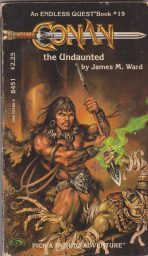 Conan (Sprague de Camp Fan): There were three “Endless Quest” Conan adventures. Conan the Undaunted, Conan and the Prophecy, and Conan the Outlaw. I didn’t buy these books when they first appeared in 1984 and 1985. I was in my late 20s and knew the books were for young readers. Why spend my hard-earned money on them? Now, in my 60s, I purchased the books at 10 times the original cover price. Senility is a distinct possibility.
Conan (Sprague de Camp Fan): There were three “Endless Quest” Conan adventures. Conan the Undaunted, Conan and the Prophecy, and Conan the Outlaw. I didn’t buy these books when they first appeared in 1984 and 1985. I was in my late 20s and knew the books were for young readers. Why spend my hard-earned money on them? Now, in my 60s, I purchased the books at 10 times the original cover price. Senility is a distinct possibility.
D&D (Black Gate): In 1979, the Dungeon Masters Guide for Advanced Dungeons & Dragons was published by TSR. Written by Gary Gygax and featuring an iconic cover painting by David Sutherland, the DMG was my first hardcover AD&D book, which I purchased as a preteen with my paper route earnings. Prior to this, I had been using the Holmes D&D set, but my friends and I eventually transitioned to AD&D. The DMG was filled with systems, procedures, advice, tools, and guidance on the creation and maintenance of a longform D&D campaign, which is the ultimate expression of tabletop gaming.
Science Fiction (Dark Worlds Quarterly): A list of 1930s Science Fiction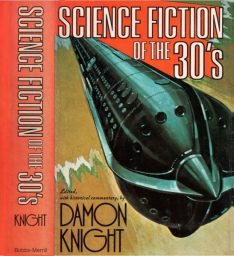 Anthologies is a pretty short. Zero. Nada. Zip. The first real SF anthology was Raymond J. Healy and J. Francis McComas’s Adventures in Time and Space in 1946. Certainly there were anths that had SF stories in them (like Phil Stong’s The Other Worlds (1940) but none that was exclusively a Science Fiction collection. So, of course, the anthology we are going to look at here is from the 1970s.
Anthologies is a pretty short. Zero. Nada. Zip. The first real SF anthology was Raymond J. Healy and J. Francis McComas’s Adventures in Time and Space in 1946. Certainly there were anths that had SF stories in them (like Phil Stong’s The Other Worlds (1940) but none that was exclusively a Science Fiction collection. So, of course, the anthology we are going to look at here is from the 1970s.
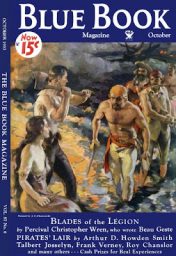 Pulp (Paperback Warrior): I’m always searching for the next great sea-adventure. In my quest for a good nautical romp, I started thumbing through digital copies of Blue Book from the early 20th century. I found a copy of the October, 1933 issue, featuring an incredible cover painting by Joseph Chenoweth, and decided to try a story called “Pirate’s Lair”. It was written by Arthur D. Howden Smith, a prolific pulp writer for the magazine Adventure, who created a number of popular serials featuring characters like Captain McConaughy, Swain the Viking, and Grey Maiden.
Pulp (Paperback Warrior): I’m always searching for the next great sea-adventure. In my quest for a good nautical romp, I started thumbing through digital copies of Blue Book from the early 20th century. I found a copy of the October, 1933 issue, featuring an incredible cover painting by Joseph Chenoweth, and decided to try a story called “Pirate’s Lair”. It was written by Arthur D. Howden Smith, a prolific pulp writer for the magazine Adventure, who created a number of popular serials featuring characters like Captain McConaughy, Swain the Viking, and Grey Maiden.
D&D (Grognardia): An overriding concern of this blog since its start are the literary precursors of Dungeons & Dragons. Believe it or not, this has often been a somewhat contentious subject, since there’s plenty of conflicting evidence on the matter, not to mention a fair bit of obfuscation from the various parties involved. The subsequent history of both D&D and fantasy roleplaying games more generally, including their explosive, faddish popularity in the late ’70s and early ’80s, has only further muddied the waters.
Cinema (Swords Lore): To get it out of the way, Die Hard is a Christmas film through and through beyond a shadow of a doubt. I will be explaining why exactly later on but I wanted to be up front about this bona fide holiday classic and drive off anyone who would dare refute it. Last week’s post examined the intersection of Christmas stories and horror, but now we turn to another slightly unorthodox mashup of genres—action and Christmas stories.
through and through beyond a shadow of a doubt. I will be explaining why exactly later on but I wanted to be up front about this bona fide holiday classic and drive off anyone who would dare refute it. Last week’s post examined the intersection of Christmas stories and horror, but now we turn to another slightly unorthodox mashup of genres—action and Christmas stories.
Review (DMR Books): Howard Andrew Jones is one of many individuals instrumental in the resurgence of S&S today. He is a fan, first and foremost, with many friends within our little fandom. Howard is also an author. His bibliography, while not yet enormous, is well favored and received by readers. The setting of Lord of a Shattered Land draws inspiration from history. Hanuvar, the protagonist, is drawn from Hannibal of Carthage.
Gaming (Lotus Eaters): Creative Dis-assembly.
Review (With Both Hands): This is a funny, funny book. It is loveably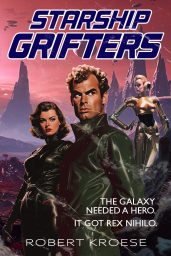 absurd and ridiculously extravagant. I had this book sitting in my TBR pile for years, but it was just the thing when I finally picked it up. Starship Grifters is a Mad Magazine style parody wrapped around a nugget of another story that works best if you are pretty familiar with the things it is making fun of, in this case mostly OG Star Wars, although there are lots of other pop culture references in here too.
absurd and ridiculously extravagant. I had this book sitting in my TBR pile for years, but it was just the thing when I finally picked it up. Starship Grifters is a Mad Magazine style parody wrapped around a nugget of another story that works best if you are pretty familiar with the things it is making fun of, in this case mostly OG Star Wars, although there are lots of other pop culture references in here too.
D&D (Monsters & Manuals): Paging through the AD&D corpus and thinking about what it all has to say about religion, one is struck by two things. The first is the very high degree of syncretism on display. The creators invented many of their own species of (usually polytheistic) religious belief, and these are mixed in with real-world religions that are typically dead (so that, for instance, the Outer Planes are thought to be home to a variety of ‘pantheons’ such as the Greek, Chinese, Babylonian, Finnish, Egyptian and so on).
New (Dark Worlds Quarterly): The Book of the Black Sun is thirty-two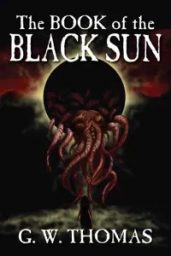 Lovecraftian tales of terror arranged in eight sections, each containing a micro, a flash, shorter story and a longer story. Motifs of strange books, evil creatures and spinning disks that form doorways to other realms are woven throughout the tales, making the final product a creepy, self-referential mandala in itself. The first in a series of volumes.
Lovecraftian tales of terror arranged in eight sections, each containing a micro, a flash, shorter story and a longer story. Motifs of strange books, evil creatures and spinning disks that form doorways to other realms are woven throughout the tales, making the final product a creepy, self-referential mandala in itself. The first in a series of volumes.
Tolkien (Notion Club Papers): From The name Nodens by JRR Tolkien – Report on the excavation of the Prehistoric, Roman, and post-Roman sites in Lydney Park, Gloucestershire. Reports of the Research Committee of the Society of Antiquaries of London. 1932. The name Nodens occurs in three inscriptions from the excavation, and may also have occurred in a mosaic.
RPG (Wert Zone): Baldur’s Gate III – now officially the Game of the Year™ – is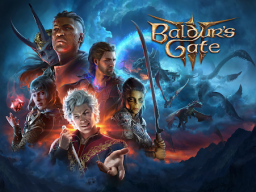 a massive, sprawling, roleplaying game set on the Dungeons & Dragons world of Toril, better known as the Forgotten Realms. It is the sequel to Baldur’s Gate and Baldur’s Gate II: Shadows of Amn, two of the greatest roleplaying games (and in fact video games full stop) of all time.
a massive, sprawling, roleplaying game set on the Dungeons & Dragons world of Toril, better known as the Forgotten Realms. It is the sequel to Baldur’s Gate and Baldur’s Gate II: Shadows of Amn, two of the greatest roleplaying games (and in fact video games full stop) of all time.
Tolkien (Ink and Fantasy): In this video we explore the beliefs of J. R. R. Tolkien on the subject of the Roman Empire, as well as how Rome influenced Middle Earth and the Lord of the Rings!
Art (Geeky Nerf Herder): The art of Norman Rockwell.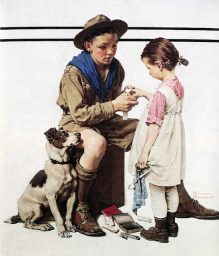
Pulp (DMR Books): Seabury Quinn was the most popular author amongst the readers of Weird Tales magazine during its original run. Robert E. Howard called Quinn “the king-favorite of Weird Tales fans,” and with good reason. Quinn’s stories–usually featuring his occult detective, Jules de Grandin–appeared in about every other issue of WT for years and years. Weird Tales scholar, Terence Hanley, puts the count at one hundred forty-six tales over roughly thirty years.
Edgar Rice Burroughs (Sanctum Secorum): Welcome to the Sanctum Secorum podcast, where we plumb the depths of Appendix N as it pertains to the Dungeon Crawl Classics Role Playing Game. We’re here to help you serve these literary offerings at your DCC RPG table.
Fiction (Lawrence Person): When Pulphouse first unveiled the short story paperback, I remember thinking “That’s stupid.” For all they bragged about “buying a single story for $1.95,” you could buy an entire issue of Asimov’s (with 5-10 times as much content) for $2.50. And, indeed, they were not swift sellers. Though a few of these (the Wolfe, the Lansdales, etc.) became slightly collectable over the years. (And a few of the companion Short Story hardbacks even more so.)
Games (Essential Malady): It has been over twenty four years since Jagged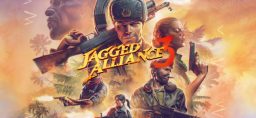 Alliance 2 released on PC which was the last major game in the series though a stand-alone expansion Jagged Alliance 2: Unfinished Business was released in 2000 — a few years before the demise of Sir-Tech which had been better known for the Wizardry series which also saw its eighth and final release in 2001.
Alliance 2 released on PC which was the last major game in the series though a stand-alone expansion Jagged Alliance 2: Unfinished Business was released in 2000 — a few years before the demise of Sir-Tech which had been better known for the Wizardry series which also saw its eighth and final release in 2001.
Life (Isegoria): Greg Ellifritz was recently watching a video where a guy in Thailand takes his belt off to whip another guy, and that guy pulls out a knife and stabs him in the neck: First of all, knife wounds (both slashes and stabs) are far less lethal than gunshot wounds.
Cold Steel (Frontier Partisans): I far prefer a fixed blade to a folder, and my EDC is a Benchmade blade that is almost 30 years old and has long since been discontinued. I’ve carried others, including my Becker Kephart, which I love, and tend to favor in the field, but the Benchmade is just Stuff That Works. It’s handy, cuts well and has enough of a point if I need it. It’s also small and unintimidating, and (mostly) doesn’t make people nervous in town.
EDC is a Benchmade blade that is almost 30 years old and has long since been discontinued. I’ve carried others, including my Becker Kephart, which I love, and tend to favor in the field, but the Benchmade is just Stuff That Works. It’s handy, cuts well and has enough of a point if I need it. It’s also small and unintimidating, and (mostly) doesn’t make people nervous in town.
Please give us your valuable comment